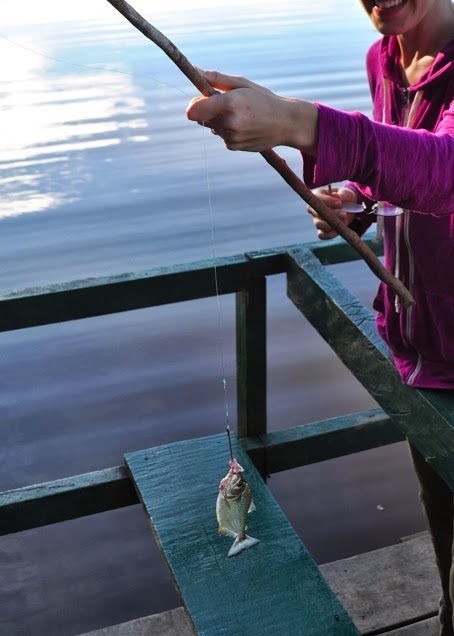Question for class 2A: Why do macaws lick clay?
When we arrived, we noticed a hawk perched on a branch near the clay lick. This was bad news for us because macaws are afraid of hawks. Eventually the hawk flew away and we noticed 8 or 9 macaws in the tree tops above, still very far away. Our guide noticed that they began to descend little by little toward the clay lick and we were very optimistic that we'd be able to see them up close. However, another hawk showed up and scared them away. Then a couple of loud boats came by and sealed the deal. No macaw close-ups for us.
We later witnessed Willian wearing the baby Bjorn with the 3 year old in it while hiking back to the lodge. He was sporting an supressed grimace on his face.
On our way back to the lodge we happened upon a group of squirrel monkeys eating fruit in a palm tree. We had to go off the main path to see them but it was worth it! We enjoyed watching them jump from treetop to treetop. Our guide, Robin, got really close with our camera and snapped a couple of great shots:
We had to take a boat about 15 mins along the river to arrive at his farm/clinic. We then took a tour of his farm. The chaman doesn't speak English so Robin (who once trained as a chaman's apprentice) translated for the group. Here were some of the things we saw:
-Chuchuhuasi - painkiller
-Cordoncillo - used to make Novocain. We chewed some of the leaves and sure enough, our mouths went numb.
-Sanipanga - used as a red dye
At the end of the tour we sampled a couple of elixers which all tasted the same - like strong cough syrup.
After our visit to the chaman, we went back to the lodge for dinner. Right after dinner a few of us went on a night hike with Robin which turned out to be almost deadly.
We made our way through complete darkness in search of creatures of the night with only a few flashlights to guide the way. The first thing we happened upon was a colony of bullet ants having their way with some sort of shrub. Robin cautioned us to keep our distance from these massive, venomous ants, before proceeding to get bit by one of them. All was well, however, as he claimed he'd built up an immunity to them over the years (though still very painful!).
We were all now thoroughly worried about what other sorts of things we might unknowingly brush up against in the darkness of the Amazonian night. A few minutes later, someone's flashlight caught a spider descending from a tree right between the two Canadian girls. Intrigued, someone asked Robin what sort of spider it was. Robin immediately freaked out and pushed everyone away from the spider. He explained it was a Wandering Spider, one of the world's deadliest. He then proceeded to probe the spider with a stick, which I'm sure the spider appreciated. At this point (about 10 minutes into the 40 minute hike), Robin decided it was best to head back. On the short walk back to the lodge we also saw a tarantula and a wolf spider. All in all, a short but successful night hike, mainly because we made it back alive.
Upon our return to the lodge, folks were hanging out at the bar. William called me over saying he had something to show me. Already suspicious, I slowly approached him knowing he had something up his sleeve. He literally did. He straightened his arm and out crawled a giant tarantula. I was worried the spider would bite him, especially after our encounters on the night hike, but he told me that even if it bit him, it would just itch like a mosquito bite. He then passed the tarantula off to one of the other guides at the bar who escorted it back into the woods.
We spent the next few hours draining a bottle of Pisco with Robin, the Canadian girls and their Peruvian guide. We learned a little more about Peruvian foods (including brains), marriage customs (most don't get married because they can't afford it) and shared a few laughs.
I slept a lot better that night, and the next morning we departed around 8am for our journey back to Cusco. Below are a few more shots from the beautiful Amazon.





 RSS Feed
RSS Feed
